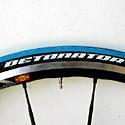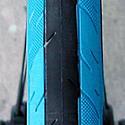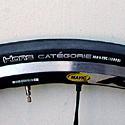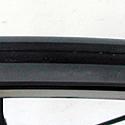
Recently on Cyclingnews.com |
Reviews
MTB tyre company hits the road
Maxxis Xenith Hors Categorie & Detonator tyres and Fly-Weight tubes, November 4, 2003
By Jeff Jones
Maxxis International is not just another bicycle tyre company. Started in 1967, producing tyres for bicycles and motorcycles, Maxxis claims it has grown to be the largest bicycle tyre manufacturer in the world, employing over 7,000 people with distribution in over 100 countries. In addition to bicycles and motorcycles, Maxxis has branched out into making tyres for automotive, light truck, lawn & garden, ATV, and industrial purposes.
Maxxis is a well established brand name in mountain biking, specialising in downhill tyres. However for a company this size, it's not surprising that Maxxis now wants a slice of the road and MTB cross country markets, making an announcement in late 2002 to that effect. Maxxis has been making road tyres since the beginning in 1967, but they have not been heavily promoted.
In this test we look at a sample of Maxxis' road tyre range: the Xenith Hors Categorie racing tyre and the Detonator training tyre. Both are 700x23c, foldable, and both are very light at around 230g. Interestingly the Detonator we tested weighed a fraction less than the Hors Categorie, which is not what you'd expect for a training tyre. We also tested the Maxxis 700x18c Fly-Weight tube, which weighs a mere 55g and is claimed to be the "lightest butyl tube known to mankind".
Features
Both the Detonator and Xenith Hors Categorie have dual compound treads, which Maxxis claims makes for better wear and cornering traction. In both cases the harder tread (62a durometer for both) is in the middle with the softer tread at the sides (the Detonator's is 57a, the Hors Categorie's 55a). With a 120 threads-per-inch casing, the Xenith Hors Categorie is only available in a folding version while the Detonator comes in 27 tpi and 60 tpi wire-bead versions and a 60tpi folding version.
Testing environment
Testing was done on fairly good roads and dry conditions in Sydney, and in generally appalling conditions in Belgium. The B elgian weather accelerates tyre death like nothing else, as the often wet roads end up covered in mud, small stones and that famous Belgian grit which gets into absolutely everything. Combine that with hail, rain and snow (vary the order according to the time of day) and you get the perfect field laboratory in which to test cycling equipment.
Wear
For most riders, tyre wear is one of the most important features of a tyre. Barring premature slashes and sidewall cuts, you expect to get between 2,000-3,000 km out of a rear, and 8,000-10,000 km out of a front racing tyre, with the rear tyre wearing faster because it transmits your pedalling effort to the road.
The Xenith Hors Categorie on the rear wheel was put through a rather vigorous testing regime. It coped with the first 2,000km in Sydney quite well, and I was pleasantly surprised not to see much wear on the tread after this distance. However the transition to Belgium soon took its toll, and the tyre was subjected to all the weather conditions described above on the first day out along the canal. After less than another 1000 km, the tread was still looking in remarkably good shape, but the tyre felt like a badly glued on single, as the sidewalls had started to deteriorate. It had to be... retired.
I am partly to blame for this of course, as after washing the bike down at the end of the ride I was generally more interested in a hot shower rather than attempting to dry the tyres. I'm fairly sure that would have extended the life of the poor Hors Categorie a little longer. Still, 3,000 km on the rear tyre is quite good for a high performance lightweight racing tyre.
The Detonator enjoyed a better life, as it had the prime position on the front wheel. After 8,000-9,000 kilometres it was time for a change, but there were no sidewall bulges by this stage.
Performance
Being early in the season I didn't really get a chance to test these tyres under racing conditions, which often bring out the best and worst in tyres. During training they performed well in some fairly nasty weather. Most importantly, the Hors Categorie felt quite safe when cornering in the wet, unlike some slicks that slip around a little too much for my liking. The Detonator also gave no problems, although it was under a lot less pressure, being on the front.
As mentioned above, both tyres weigh in at around 230g, and this is at the mid to lower end of the racing tyre weight scale. In cycling, lighter weight almost always equals faster performance, but whether you actually notice it is another thing!
Maxxis Fly-Weight tubes
I had somewhat mixed results with the Maxxis Fly-Weight tubes. I'm generally wary of super-lightweight tubes because they have a tendency to fail when I'm doing things like pumping up tyres in a hurry. I normally don't pinch tubes when putting them in the tyre, but I managed to do so with the first Maxxis Fly-Weight. I was extra careful with the next one and that survived for some time, until I tried to put some more air in it one day with a hand pump and broke the valve. Maybe it's just me.
Overall
The Detonator and the Hors Categorie road tyres gave very favourable performance in generally unfavourable conditions. The wear is as good as or better than expected for a light tyre, and the traction and overall 'feel' was on the whole very good. I wasn't that enthused by the Maxxis Fly-Weight tubes, but people who are used to such things as latex tubes might get more life out of them.
Recommended retail price: US$37 (Xenith Hors Categorie); US$24.29 (Detonator);
US$8/US$9 (standard/long valve)
Pro: Light, better than average wear, good road performance
Con: Hors Categorie developed bulging sidewalls, Fly-Weight tubes too
fragile
More information: Maxxis'
website
Cyclingnews Ratings: ![]() (Tyres)
(Tyres) ![]() (Tubes)
(Tubes)
What do you think of the Maxxis road tyres and tubes? Let us know






